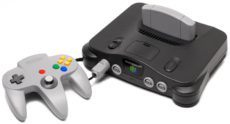| Nintendo 64 | |
|---|---|
 File:Nintendo 64 logo.png | |
| Manufacturer | Nintendo |
| Type | Video game console |
| Generation | Fifth generation |
| First available | |
| Media | ROM cartridge |
| Controller input | Nintendo 64 controller |
| Predecessor | Super Nintendo Entertainment System |
| Successor | Nintendo GameCube |
| Article on Nintendo Wiki | Nintendo 64 |
The Nintendo 64 (ニンテンドー64, Nintendō Rokujūyon), often abbreviated as N64, is Nintendo's third home video game console for the international market. Named for its 64-bit processor, it debuted on June 23, 1996 in Japan, and was later released in North America on September 29, 1996, and in Europe and Australia on March 1, 1997. As of March 1, 2009, 5.54 million units were sold in Japan, 20.63 in America, and 6.75 in all other regions, leading into a total sale of 32.93 million units sold.
On January 21, 1999, the Super Smash Bros. series debuted on this system with the original Super Smash Bros. in Japan, which was later released in North America that April. While not the best-selling game on the N64, it was the predecessor of Super Smash Bros. Melee which became the Nintendo GameCube's best selling title and spawned an equally successful sequel for the Nintendo Wii, Super Smash Bros. Brawl.
Another version of the Nintendo 64, called the iQue Player (神游機) is a video game system made by iQue Ltd., Nintendo's Chinese subsidiary. It is a variation of the Nintendo 64 hardware, specifically designed for the Chinese market.
In the Super Smash Bros. series
- A Nintendo 64 can be seen in the trophy room in Super Smash Bros. Melee, with a copy of Super Smash Bros.
External links
- iQue Player website, in Chinese.
| Nintendo consoles | |
|---|---|
| Home consoles | Color TV-Game 15 · Nintendo Entertainment System · Super Nintendo Entertainment System · Virtual Boy · Nintendo 64 · Nintendo GameCube · Wii · Wii U |
| Handheld consoles | Game & Watch · Game Boy · Game Boy Color · Game Boy Advance · Nintendo DS · Nintendo 3DS |
| Hybrid consoles | Nintendo Switch |